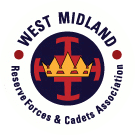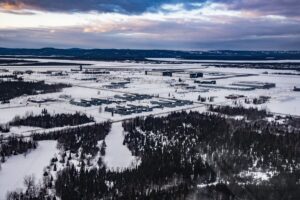 In March 2023 nine British Army personnel from 37 Signal Regiment were deployed on a two week training exercise to Labrador in Canada as part of a Canadian 5 Division annual Arctic Company Response Group (ARCG) validation activity. Giving them the opportunity to operate in cold weather conditions and practice battle task standards such as offensive patrolling and urban operations.
In March 2023 nine British Army personnel from 37 Signal Regiment were deployed on a two week training exercise to Labrador in Canada as part of a Canadian 5 Division annual Arctic Company Response Group (ARCG) validation activity. Giving them the opportunity to operate in cold weather conditions and practice battle task standards such as offensive patrolling and urban operations.
The initial journey saw the soldiers land at 5 Canadian Air Wing, Goose Bay in the Newfoundland region of Canada where they were met by several officers of the Canadian Army. The aim of the exercise was to build relations with the allied forces, as well as to share knowledge on technologies and tactics employed by the Canadian Army.
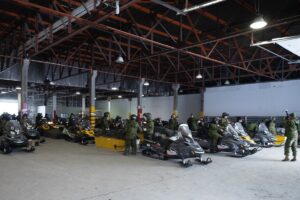 The following day they received a brief that consisted of the mission that was to be undertaken, the presence of mind that would be needed to sustain themselves (and kit) in the field, whilst also remaining tactically aware of any enemy presence in the area of operation. After making an assessment on how best to deploy the nine British personnel for maximum operational effectiveness, it was decided that four personnel would stay at 5 Wing and five would deploy out into the field, integrated across three platoons and a HQ field-based element.
The following day they received a brief that consisted of the mission that was to be undertaken, the presence of mind that would be needed to sustain themselves (and kit) in the field, whilst also remaining tactically aware of any enemy presence in the area of operation. After making an assessment on how best to deploy the nine British personnel for maximum operational effectiveness, it was decided that four personnel would stay at 5 Wing and five would deploy out into the field, integrated across three platoons and a HQ field-based element.
The rest of the day consisted of preparing the Light Over Snow Vehicles (LOSVs), with sleds, to make the 400km round journey into the north of the Newfoundland province. British troops were given the opportunity to be familiarised with the C7 rifle, basic survival equipment and the communication technologies that would be utilised including the Track24 GPS and DTCS satellite communication radio.
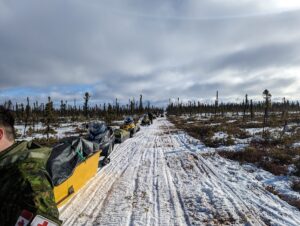 The exercise began with 100 LOSVs and 150 soldiers deploying from hanger 5 of the Air Wing base. For the soldiers in the field, the next six days consisted of 8 hour LOSV rides over harsh terrain, most notably sea ice crossings and mountainous valley trails. The British forces back at base were tasked with maintaining the vital lines of communication back to the base for all replenishment requests and status updates on the overall progress of the exercise.
The exercise began with 100 LOSVs and 150 soldiers deploying from hanger 5 of the Air Wing base. For the soldiers in the field, the next six days consisted of 8 hour LOSV rides over harsh terrain, most notably sea ice crossings and mountainous valley trails. The British forces back at base were tasked with maintaining the vital lines of communication back to the base for all replenishment requests and status updates on the overall progress of the exercise.
Days one and two of the field phase were used as acclimatisation days for soldiers deployed to the field, with temperatures dropping to -250C at night. Past this point the exercise began to ramp up, with first contact with the enemy coming on day three of the field phase at the most northern point of the Area of Operation. From this moment, the order from the Commanding Officer was to stage a fallback of the three platoons over a number of days until all elements returned safely to the base at Goose Bay. 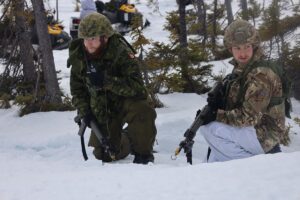 In order to achieve this, each platoon was to set a number of defensive positions to provide the forward most deployed platoon to collapse their position and fallback. Periods of contact would range from 45 minutes to several hours, with the fallback initiated from the Company HQ out on the ground. Once all platoons had moved back to the RV point on day six (company HQ’s location), the commanding officer called an end to the exercise and a debrief was held out on the ice. Once returned to base, British forces spent the remaining hours maintaining the kit that had been utilised in the field and participating in a social event in the mess.
In order to achieve this, each platoon was to set a number of defensive positions to provide the forward most deployed platoon to collapse their position and fallback. Periods of contact would range from 45 minutes to several hours, with the fallback initiated from the Company HQ out on the ground. Once all platoons had moved back to the RV point on day six (company HQ’s location), the commanding officer called an end to the exercise and a debrief was held out on the ice. Once returned to base, British forces spent the remaining hours maintaining the kit that had been utilised in the field and participating in a social event in the mess.
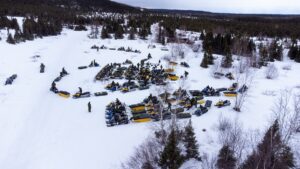
Overall, the exercise was hugely successful, highlighted by two British soldiers receiving two of the six Commanding Officer’s coins that were awarded at the end of the week. One soldier commented; “I think the exercise was an excellent show of how well British troops can integrate with our allied forces and share knowledge that will ultimately benefit both parties. The Canadian forces were very welcoming and extremely knowledgeable in how to operate in an extremely cold environment.”
Find out more about 37 Signal Regiment
